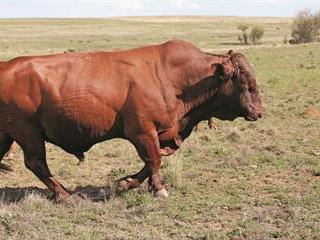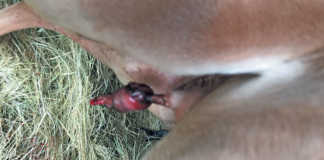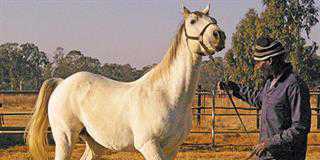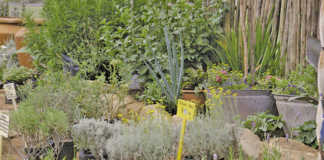
Holomo Lebona, cattle and mutton Merino sheep farmer in the Free State since 2009, says that his family’s close ties to cattle taught him to see Bonsmaras as investments.
Holomo describes himself as a town mouse.
“Ek is eintlik ‘n dorpsjapie (I’m actually a townie),” he says. However, he has always wanted to farm and his family history is deeply connected with cattle.
“During the Second Anglo-Boer War, when Kitchener applied his scorched earth policy, my family in the-then Republic of the Orange Free State protected the Bothas,” says Holomo.
“The Bothas were an honest family and after the war they gave land to my family to farm. After the 1913 Land Act, no Africans were supposed to own land, but because of the agreement with the Bothas, my grandmother was allowed to keep it. She lived there till 1960, when she was 103.”
Land restitution was instigated in the early years of democracy, and in 1996 Holomo immediately thought of his grandfather’s land. But due to the land claims’ cut-off date, he was unable to claim the old family farm.
Holomo, who studied political and administrative science at tertiary level and for a time worked as a director in the office of the minister of education, says that his family farm’s cattle had put him and his parents through high school and university.
“We were taught that cattle are the best investment,” he recalls.
He is certain that his primary and secondary education – which included English, Afrikaans, Sesotho, Latin, botany, zoology and physiology – has helped him have a better grasp of farming.
Today, Holomo has 172 Bonsmaras and about 280 mutton Merino sheep on his own farm, the 1 331ha De Rust near Steynsrus.
The farm is divided into eight camps and Holomo keeps bulls and cows and rams and ewes separate, only adding the males when necessary. He puts one bull to about 27 females.
“I placed two bulls now and aim to have calves by September,” he says.

Holomo Lebona says that his family’s ties with cattle farming taught him to see the animals as an investment.
The camp closest to the farmhouse is run as a maternity section, and animals requiring special care are also kept here.
Holomo’s wife, Maria Mosela Lebona, who has a nursing background, assists with animal health. Holomo says that her on-farm hygiene standards are often on par with human hospital standards.
Holomo makes use of the department of agriculture’s free vet services for regular animals health issues, and consults a private Kroonstad vet for more serious cases.
In addition to animal health, Maria assists with record-keeping, while his son, Mokhalajoe, helps with administration.
Breeding Bonsmaras
Holomo recently delivered about 180 weaner calves to the Sernick feedlot near Edenville. At that stage, his weaners weighed about 220kg.
“Originally I favoured Nguni, but then Patrick Sekwatlakwatla, the head of Sernick’s corporate social investment programme, preached Bonsmaras like a real evangelist,” he recalls.
Holomo discovered Sernick following disappointing relationships with other feedlots in the area.
He says that his relationship with the agricultural organisation is good, and that it assists him and other emerging farmers with information days and regular farm visits, amongst others.
According to Holomo, Patrick’s farm visits make a real difference to a farming operation and he assists in transforming many farms into productive units.
Holomo refers to him as “a cattle farmer’s encyclopaedia”, while Patrick says that when visiting De Rust, Maria can identify which animal was bought where and what problems, if any, it experienced.
Before selling to the Sernick feedlot, Holomo would take his Bonsmaras to everyday auctions at two years of age.
He also tried a feedlot in Bloemfontein, but was unhappy with the arrangement.
“They take the animal on hoof, and don’t want to tell you what the end-product is after slaughter, or give weight and classification. When you buy on hoof the aggregate weight is not reliable,” he says.
According to Holomo, the feedlot system offered by Sernick was unknown amongst black farmers.
“To take a calf to saleable age used to take me two years. With Sernick, I wean at six months and then take the animal to the feedlot, where it’s fed for three to four months. I make a good profit and save about 14 months of caring for the calves.”
The Sernick feedlot also provides market analysis and farmers are paid on classification and weight. Both the standing feedlots and projected profits are clearly set out. In addition, the feedlot’s bull exchange is beneficial.
According to Patrick, farmers under Sernick mentorship “can do a bull exchange with a SP [stud proper] Bonsmara bull, where they give weaners in exchange”.
If a bull’s value is, say, R25 000, a farmer can exchange it for six weaners weighing 220kg at R19/kg.
“The aim is to encourage emerging farmers to practise livestock improvement,” Patrick says.
Sernick also hosts training days for emerging farmers, farm management courses, carcass competitions and educational farmer days.
Feed and veld
Despite the drought, Holomo’s Bonsmaras are in exceptional shape.
“They proved themselves to me this year,” he says.
He attributes his Bonsmaras’ good health primarily to the Sernick feed he uses.
“Goedkoop is duurkoop [cheap is expensive]. Other farmers would criticise me for buying such expensive feed, but once they looked at the content of the feed, and saw the condition of my animals, they bought the same.”
His Bonsmaras and Merinos favour red grass [Themeda triandra], which grows in the area, and find it most palatable when soft. Although the area is not suited to crop production, Holomo plants about 400ha of crops for feed, especially for winter when grass reserves are low.
Growing feed was especially important during the recent drought, when grass reserves were extremely low.
Near the middle of January, the farm received between 34mm and 40mm of rain, depending on the area.
“I’ve never seen the farm this way. The natural grass won’t have a chance to grow now before winter,” says Holomo.
Although the rain that eventually fell turned the veld from yellow to green, the grass on the farm was barely 5cm high towards the end of January.
In summer, Holomo plants long-standing teff, Smuts finger grass, Eragrostis and stooling rye.
He aims to plant more sorghum for feed as it is less expensive than maize and can be eaten while the Bonsmaras and Merinos stand in the land. He is also keen on sweet reed because it does not need to be harvested or stored, can be eaten on the land and does not require insecticides.
Mutton Merino
According to Holomo, his mutton Merino sheep also withstood the drought well, although he did have to supplement feed with Sernick pellets and teff and lucerne he had planted.
He shears the sheep in September and sells the wool to BKB in Port Elizabeth. The wool is exported to overseas markets.
“The wool is good. With the money I make, I can pay for petrol and salaries for a whole year.”
However, he says that this year the wool may be of a lesser quality than previous years, because weeds have the advantage during drought and can spoil the quality of the wool. Stock theft is also problem in the area.
READ: Stock theft
“I’m 12km from a township and sheep are seen as takeaways.”
He reports that even people passing through the area will stop and load a vehicle with sheep, and that the police once discovered an ambulance packed with stolen sheep.
Challenges
In 2000, Holomo’s first attempt at fulfulling his farming dream was met with contempt.
“I was told, no. You are black and can only buy land through the Department of Rural Development and Land Reform [DRDLR].”
Establishing and maintaining good relationships with both government and financial institutions remains one of his biggest headaches.
“In 2013, when we were first assisted by the DRDLR, a term of five years was negotiated. However, after three years I was told that I had graduated and didn’t need more assistance. But a farm cannot be viable within such a short period,” he says.
“We were also not assisted as individuals, but were clubbed together in groups. We weren’t even from the same area, and making decisions such as what crops to plant couldn’t work.”
He says that when he signed a lease – with the intention to buy – for a specific period, the department would change the lease period without notice.
Banks can also be challenging, he says, as the processes involve filling in forms, and assistants often fail to understand farming or an individual farmer’s requirements.
“Things need to be flexible. If it rains now, then I need money to plant now,” says Holomo.
Government, however, is a greater challenge than the banks, he stresses.
“The allocation for farmer assistance is part of the Treasury budget. The budget is read in February and only gets implemented in June, then there’s no more rain.”
He adds that agriculture needs the private sector to play a role in the industry.
“It can give agriculture the necessary support and capital knowledge. Government is not business-orientated.”
According to Holomo, the younger generation should be motivated to farm. To achieve this, industry has to work together to change the perception that agriculture is a dirty job.
Phone Holomo Lebona on 072 175 9166 or Patrick Sekwatlakwatla at Sernick
060 965 5004.
This article was originally published in the 4 March 2016 issue of Farmers Weekly.













